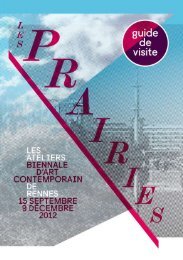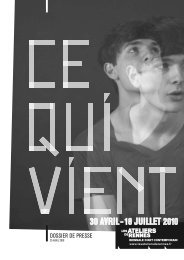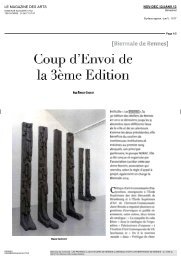Download here the Visitor's guide. - Les Ateliers de Rennes
Download here the Visitor's guide. - Les Ateliers de Rennes
Download here the Visitor's guide. - Les Ateliers de Rennes
You also want an ePaper? Increase the reach of your titles
YUMPU automatically turns print PDFs into web optimized ePapers that Google loves.
GYAN PANCHAL<br />
Dhrso, 2011. Courtesy of <strong>the</strong> artist and galery Frank Elbaz, Paris.<br />
<strong>Les</strong> Prairies's artists<br />
Production<br />
<strong>Les</strong> <strong>Ateliers</strong> <strong>de</strong> <strong>Rennes</strong> 2012.<br />
Gyan Panchal works like a<br />
geologist, probing <strong>the</strong> materials<br />
of our everyday environment,<br />
exploring <strong>the</strong>ir production cycle and<br />
<strong>the</strong>ir origin in or<strong>de</strong>r to reveal <strong>the</strong>ir<br />
story. He works with raw, mainly<br />
oil-<strong>de</strong>rived industrial materials<br />
such as polymers or plastics<br />
which he combines with natural<br />
pow<strong>de</strong>rs like graphite and coal. The<br />
forms he creates from industrial<br />
packaging situate his sculpture in<br />
<strong>the</strong> realm of concrete abstraction.<br />
It is <strong>de</strong>licate work rooted in organic<br />
and economic history in which <strong>the</strong><br />
sedimentation of <strong>the</strong> materials is not<br />
hid<strong>de</strong>n. For <strong>Les</strong> Prairies Panchal<br />
created a different sculpture for<br />
each of <strong>the</strong> two venues of <strong>the</strong><br />
collective exhibition. Although <strong>the</strong>y<br />
are autonomous works, <strong>the</strong> two<br />
sculptures are conceived as two<br />
moments of <strong>the</strong> same work – two<br />
projections into a space that was to<br />
be filled. The first stands in a 1970s<br />
building in <strong>the</strong> course of renovation,<br />
a rough predominantly concrete<br />
place, with glass walls giving on<br />
to <strong>the</strong> outsi<strong>de</strong> world. The sculpture<br />
leans against a pillar, hugging <strong>the</strong><br />
landscape. T<strong>here</strong> are three sheets of<br />
Styrofoam, curved and covered with<br />
red chalk dust. This is a material<br />
that architects use for <strong>the</strong>ir mo<strong>de</strong>ls<br />
and it suits architectonic forms and<br />
<strong>the</strong> notion of spatial projection. In<br />
<strong>the</strong> "white cube" exhibition areas<br />
of FRAC Bretagne, Panchal has<br />
<strong>de</strong>signed something different: long,<br />
crumpled isolation sheets hang on<br />
<strong>the</strong> wall down to <strong>the</strong> floor, projecting<br />
a layered, undulating relief into <strong>the</strong><br />
space. Gyan Panchal's conceptual<br />
and material exploration lightens<br />
<strong>the</strong> spatial constraints, freeing itself<br />
from gravity<br />
A. B. tr. J.H.<br />
Born in 1973 in Paris (France),<br />
w<strong>here</strong> he lives and works.<br />
63






